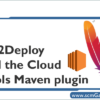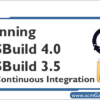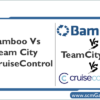
Syncro SVN Client v5.1 for Windows, Linux & MacOSX – Features
Syncro SVN Client makes easier the document and code sharing between content authors or developers. This multiplatform Subversion front-end allows you to browse repositories, check for changes, commit changes, update…
Read more »
Powerful New Amazon EC2 Boot Features – Introduction
Today a powerful new feature is available for our Amazon EC2 customers: the ability to boot their instances from Amazon EBS (Elastic Block Store). Customers like the simplicity of the…
Read more »
Upgrading Continuum – Continuum Upgradation Guide
This document will help you upgrade Continuum from 1.2.x to 1.3.3 and above. When upgrading Continuum, it could have some database model changes. Usually these changes will be migrated for…
Read more »
Apache Continuum Version 1.3.6 Beta 1 – What’s new in Apache Continuum ?
The Apache Continuum team have released a beta of Apache Continuum 1.3.6. Apache Continuum is a continuous integration server, which offers automated builds, role-based security, release management and integration with…
Read more »
Read About Windows 7 Deployment Best Practices
Windows 7 Deployment Best Practices This week, I and my colleagues are at the IT Business Edge Midmarket CIO Summit, where we are focusing on the needs and concerns of…
Read more »
Syncro Soft Announces New Release of Syncro SVN Client
Syncro Soft Announces New Release of Syncro SVN Client Syncro Soft Ltd, the producer of Syncro SVN Client, has announced the immediate availability of version 5.1 of its Subversion (SVN)…
Read more »
How to Run/Deploy Java EE applications on Amazon EC2?
Running Java EE applications on Amazon EC2: deploying to 20 machines with no money down Computer hardware has traditionally been a scarce, expensive resource. In the early days of computing…
Read more »
EC2Deploy and the Cloud Tools Maven plugin are now available
I’m pleased to announce that EC2Deploy – a Groovy-based framework for deploying Java EE applications to Amazon EC2 – is now available as part of the Cloud Tools open source…
Read more »
Cloud Tools now supports Amazon Elastic Block Store
One of the exciting new features of Amazon EC2 is Elastic Block Store, which provides truly durable storage for your instances. Prior to EBS, the contents of the file system…
Read more »
Amazon EC2 key pairs and other stumbling blocks – Guide
While working with Cloud Tools and Cloud Foundry users, I have noticed that EC2 key pairs and security group configuration are common stumbling blocks for people who are new to…
Read more »
Workforce Management Software Helps Call Centers Save Money
One way to increase revenues in your inbound call center might be via workforce management software. For call centers that realize revenue by answering calls (be they catalogues, reservation centers,…
Read more »
Running MSBuild 4.0 and MSBuild 3.5 on Continuous Integration
With Visual Studio 2010 RC released recently, we jumped on the release and began to code with VS2010. One issue that popped up was that now all builds were targeting…
Read more »
Issues Compiling VS2010 solutions (with web projects) from Nant | MSB4064 error
Recently I upgraded a project of mine (the Dimecasts code base) to use VisualStudio 2010. In the process everything worked just fine from the IDE, but when I tried to…
Read more »
JUnit 4 Test Logging Tips using SLF4J
When writing JUnit tests developers often add log statements that can help provide information on test failures. During the initial attempt to find a failure a simple System.out.println() statement is…
Read more »
Why and how to use Jetty in mission-critical production
This article is a summary of a seminar I had on the topic. If it seems like it’s a continuation of an existing discussion that’s because, to some extent, it…
Read more »
Jacksum – a java checksum utility – Introduction and usage
Jacksum, a java checksum utility Software Name : Jacksum Website : http://jacksum.net/en/index.html Version : 1.7.0 Jacksum is a platform independent checksum utility (written entirely in Java) for computing and verifying (integrity…
Read more »
Introduction of RFT(Rational Functional Testing)
Introduction of RFT(Rational Functional Testing) Functional Tester is available in two integrated development environments and two scripting languages. Functional Tester, Java™ Scripting uses the Java language and the IBM® Rational®…
Read more »
Advance Features of Smart Build Tools
Table of Contents Agile Development Challenges Deployment Challenges Build Acceleration Challenges Integration with Elastic and Cloud Computing Workflow Management Reference: Agile Development Challenges Two of the core principles of…
Read more »
Disadvantages of Bamboo – Bamboo Expert Review
Bamboo Disappointment Being a big fan of Atlassian’s Confluence and Jira, it was with much anticipation that installed Bamboo, the continuous integration (CI) engine they’ve released. Perhaps these high expectations…
Read more »
Bamboo Vs TeamCity Vs CruiseControl – Continuous Integration Expert Review
Difference between Bamboo Vs TeamCity Vs CruiseControl TEAMCITY TC pre-tested commit is good. TC integrates to Visual Studio which is our main IDE. JetBrains are more focused on supporting .NET…
Read more »
Bamboo – A Continuous Integration Server – Complete Guide
Bamboo – A Continues Integration Server Continuous integration (CI) brings faster feedback to your development process, preventing bugs from piling up and reducing the risk of project delays. Bamboo enables…
Read more »
Deployment Foundation Issues
Deployment Foundation Issues Establish Key Roles/Charter for Deployment The very first order of business is to firmly establish “who’s on first” for getting deployment done. Senior management is crucial at…
Read more »







